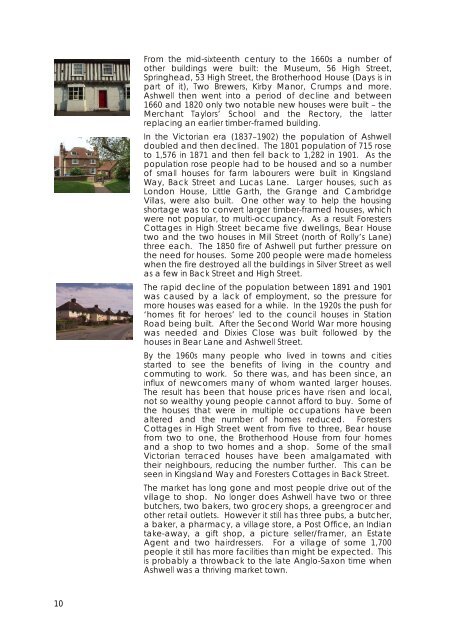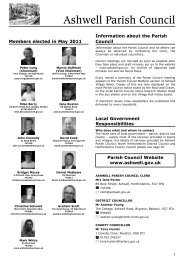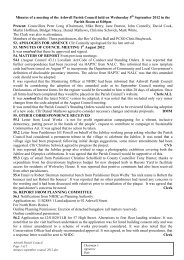Ashwell Parish Plan - Ashwell, Hertfordshire
Ashwell Parish Plan - Ashwell, Hertfordshire
Ashwell Parish Plan - Ashwell, Hertfordshire
You also want an ePaper? Increase the reach of your titles
YUMPU automatically turns print PDFs into web optimized ePapers that Google loves.
10<br />
From the mid-sixteenth century to the 1660s a number of<br />
other buildings were built: the Museum, 56 High Street,<br />
Springhead, 53 High Street, the Brotherhood House (Days is in<br />
part of it), Two Brewers, Kirby Manor, Crumps and more.<br />
<strong>Ashwell</strong> then went into a period of decline and between<br />
1660 and 1820 only two notable new houses were built – the<br />
Merchant Taylors’ School and the Rectory, the latter<br />
replacing an earlier timber-framed building.<br />
In the Victorian era (1837–1902) the population of <strong>Ashwell</strong><br />
doubled and then declined. The 1801 population of 715 rose<br />
to 1,576 in 1871 and then fell back to 1,282 in 1901. As the<br />
population rose people had to be housed and so a number<br />
of small houses for farm labourers were built in Kingsland<br />
Way, Back Street and Lucas Lane. Larger houses, such as<br />
London House, Little Garth, the Grange and Cambridge<br />
Villas, were also built. One other way to help the housing<br />
shortage was to convert larger timber-framed houses, which<br />
were not popular, to multi-occupancy. As a result Foresters<br />
Cottages in High Street became five dwellings, Bear House<br />
two and the two houses in Mill Street (north of Rolly’s Lane)<br />
three each. The 1850 fire of <strong>Ashwell</strong> put further pressure on<br />
the need for houses. Some 200 people were made homeless<br />
when the fire destroyed all the buildings in Silver Street as well<br />
as a few in Back Street and High Street.<br />
The rapid decline of the population between 1891 and 1901<br />
was caused by a lack of employment, so the pressure for<br />
more houses was eased for a while. In the 1920s the push for<br />
‘homes fit for heroes’ led to the council houses in Station<br />
Road being built. After the Second World War more housing<br />
was needed and Dixies Close was built followed by the<br />
houses in Bear Lane and <strong>Ashwell</strong> Street.<br />
By the 1960s many people who lived in towns and cities<br />
started to see the benefits of living in the country and<br />
commuting to work. So there was, and has been since, an<br />
influx of newcomers many of whom wanted larger houses.<br />
The result has been that house prices have risen and local,<br />
not so wealthy young people cannot afford to buy. Some of<br />
the houses that were in multiple occupations have been<br />
altered and the number of homes reduced. Foresters<br />
Cottages in High Street went from five to three, Bear house<br />
from two to one, the Brotherhood House from four homes<br />
and a shop to two homes and a shop. Some of the small<br />
Victorian terraced houses have been amalgamated with<br />
their neighbours, reducing the number further. This can be<br />
seen in Kingsland Way and Foresters Cottages in Back Street.<br />
The market has long gone and most people drive out of the<br />
village to shop. No longer does <strong>Ashwell</strong> have two or three<br />
butchers, two bakers, two grocery shops, a greengrocer and<br />
other retail outlets. However it still has three pubs, a butcher,<br />
a baker, a pharmacy, a village store, a Post Office, an Indian<br />
take-away, a gift shop, a picture seller/framer, an Estate<br />
Agent and two hairdressers. For a village of some 1,700<br />
people it still has more facilities than might be expected. This<br />
is probably a throwback to the late Anglo-Saxon time when<br />
<strong>Ashwell</strong> was a thriving market town.







